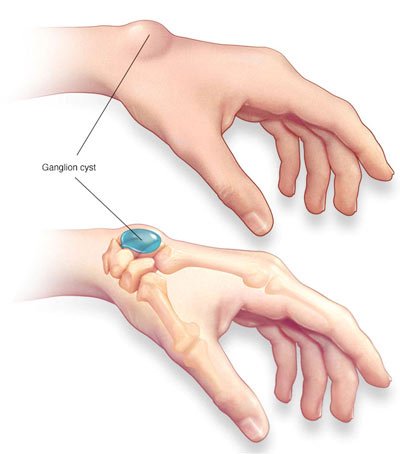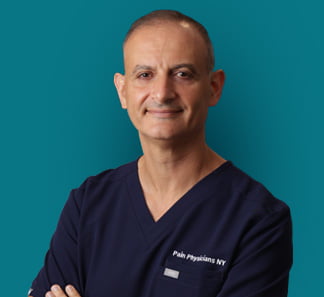While it sounds scary, a ganglion cyst is no more than a lump, usually on your hand or wrist, that isn’t related to any serious disease. Instead, it’s a result of constant pressure placed on the area, which eventually can lead to a fluid build-up. Ganglion cysts are relatively easy to treat when you rely on the best pain management doctors in Manhattan at pain management New York City. You can expect an accurate diagnosis and sound treatment advice from the wrist injury specialists trusted by 10,000 other patients.
If you’ve developed a lump on your hand or wrist adjacent to a joint or tendon, there’s a good chance it’s a ganglion cyst. A non-cancerous lump, a ganglion cyst is a fluid-filled sac that’s usually round or oval. It ranges from the size of a pea to an inch or more in size. Sometimes, it may appear, change size or even disappear.
While they usually develop on your hands or wrists, ganglion cysts can also show up on your knees, ankles and feet. If they press on a nearby nerve, they may be painful. If you’re experiencing pain or reduced movement from a lump near a joint, have it evaluated at pain management center NYC, where you’ll find pain doctors with the most advanced diagnostic tools and interventional treatment options designed to keep you pain-free while you heal.
Symptoms of a Ganglion Cyst

Most of the time, ganglion cysts are painless. You may experience some discomfort if the cyst presses on a nerve. This kind of pressure on a nerve can cause numbness, muscle weakness or a tingling sensation. An enlarged cyst can make it difficult to bend or straighten your wrist or other affected joints.
Causes and Risk Factors for Ganglion Cysts
The cause of these cysts isn’t known. A ganglion cyst in the wrist commonly occurs among gymnasts or anyone who continually stresses the wrist joint. Other risk factors for developing ganglion cysts include:
- For unknown reasons, these cysts are more common in women.
- The people most commonly affected are between the age of 20 and 40.
- Previous tendon or joint injury. When you’ve previously injured a tendon or joint, your risk of developing a ganglion cyst increases.
- Ganglion cysts in the fingers are more likely if you have arthritis, particularly if the condition affects the tips of your fingers.
Ganglion cysts seem to occur when tissue bulges out of place. A possible cause of ganglion cysts is trauma that creates a small hole, which may allow fluid to escape and then form a cyst.
Diagnosing a Ganglion Cyst in the Hand
Top pain management specialists in New York are familiar with ganglion cysts and may confirm a diagnosis by shining a light on the lump to see if it’s clear or a solid mass, which may indicate another condition. Imaging tests also help confirm the mass to rule out a tumor or arthritis.
By drawing fluid from the ganglion cyst, your pain doctor also can tell if your discomfort is caused by the cyst. Most cysts of this nature are treatable, even if they cause you some hand pain. Seek out pain management doctors near me to ensure you get the best care and the fastest treatment.
Ganglion Cyst Treatment
Your pain doctor may decide to wait and see if the cyst goes away on its own, especially if it isn’t causing you any wrist pain. Ganglion cyst in the wrist treatment is recommended to relieve discomfort or embarrassment about its appearance. Your NYC pain management doctor may recommend:
- Immobilization with a brace or splint. Keeping the area immobilized with a brace or splint often relieve symptoms. Activity increases pressure on a nerve and may also cause a ganglion to increase in size. Decreasing its movement reduces the pain and also causes the ganglion cyst to decrease in size.
- This is a procedure in which your doctor drains the fluid from the ganglion. This doesn’t remove the entire cyst; it only removes the fluid inside it. In some cases, after this procedure, the ganglion eventually returns. In others, it just fades away.
If you have a noticeable lump near a tendon or joint — or if you’re experiencing a decreased range of motion or pain in your hand, wrist, foot or ankle — contact the top pain management doctors at Pain Management NYC. If your doctor confirms you have a ganglion cyst, the best NYC pain specialists can perform the best ganglion cyst treatment for you.

Boleslav Kosharskyy, MD, is a top-rated, best-in-class interventional pain management doctor. He is board-certified in Anesthesiology, Interventional Pain Medicine, and Palliative Care.
Dr. Kosharskyy is an Associate Professor of Anesthesiology and Rehabilitation Medicine at Albert Einstein Medical College. He’s also the Associate Medical Director of Pain Medicine and Director of Anesthesia for the Joint Replacement Center at Montefiore Medical Center and Albert Einstein Medical College.
He is an active member of the American Society of Anesthesiology (ASA), the American Society of Regional Anesthesia and Pain Medicine (ASRA), and the New York State Society of Anesthesiologists (NYSSA)
